You may have thought of cutting back on or even quitting sugar. But how exactly should you go about it, and, more importantly, how can you achieve the greater goal of overcoming excessive cravings for sweetness?
From 2005 to 2009, at least 74 percent of packaged or processed foods contained added sugars. Even if you don’t have the habit of eating sweets, you may unintentionally consume sugar in excess. For instance, added sugars have dozens of names, so you might not even know you are eating them despite reading ingredient labels.
Nevertheless, quitting sugar is not an impossible mission. Many people face challenges not because they cannot quit but because they don’t know how or they set overly ambitious goals.

You can break it down into steps: First reduce sugar, then quit altogether, and eventually overcome sugar cravings.
The benefits of this approach are no different from quitting sugar directly. Dr. Jason Fung, a nephrologist specializing in reversing Type 2 diabetes and intermittent fasting, likened it to swimming. Some prefer easing into the water to adapt to the temperature, while others dive right in. Both approaches can achieve the same ultimate goal.
“Just like we advise people with any addiction,” Jessica Russo, a clinical psychologist in Philadelphia with a doctorate in psychology, told The Epoch Times, “every day, just [cut] your sugar down a little bit.”
“The process of quitting sugar is about retraining the palate,” said Lorenzo Cohen, professor and director of the integrative medicine program at MD Anderson Cancer Center, during an interview with The Epoch Times. Once people apply this, they will gradually discover that even items with very little sugar taste quite sweet, and unexpected changes will occur in the body.
The Epoch Times interviewed over a dozen experts and reviewed scientific studies to compile the most effective methods for quitting sugar.
Step 1: Reduce Sugar Intake
Avoid High-Sugar Foods
Reading labels is often the first habit many people adopt when quitting sugar or embarking on a diet. When reading labels, there are two key aspects to focus on: the ingredient list and the sugar content per 100 grams or serving.
“There’s more than 60 names for sugar,” Amy Gonzalez, a registered dietitian, told The Epoch Times.
These include barley malt, dextrose, sucrose, and rice syrup.

Sugar has over 60 names that could appear on food labels. (Illustration by The Epoch Times, Shutterstock)
Ms. Gonzalez stated that among these added sugars, those with high fructose content, such as high-fructose corn syrup and agave nectar, are more detrimental to the body. These may harm the liver and lead to insulin resistance.
“The food industry puts all these forms of sugar in our food and lists their chemical names on the package,” Laura Schmidt, professor of health policy at the University of California–San Francisco, wrote in an email to The Epoch Times. “This is confusing for people.”
Ms. Schmidt shared a simple way to identify sugar: Look for chemical names ending in “ose,” such as “lactose” (sugar in milk). They likely indicate sugar.
Another trick: “If a product has more than a few ingredients, and some are unfamiliar sounding, then just don’t eat it,” she added.
Even in foods that do not taste sweet, like crackers or salad dressings, you might still find sugar listed in the ingredients.
One tablespoon of Heinz Tomato Ketchup (17 grams) contains 4 grams of added sugar. A Big Mac from McDonald’s has 7 grams of added sugar. In a large Big Mac combo meal (with a large Coca-Cola and a large serving of fries), the total added sugar content reaches 84 grams. Even potato chips and other other savory snacks may contain sugar.

According to the U.S. Food and Drug Administration (FDA), if the added sugar in each serving of food is below 5 percent of the Daily Value (DV)—50 grams per day based on a 2,000-calorie diet—it is considered a product with low added sugar. If it exceeds 20 percent, it is regarded as a high-added sugar product.
As per the UK National Health Service (NHS), foods with less than 5 grams of sugar per 100 grams are categorized as low-sugar, those with sugar content ranging from 5 grams to 22.5 grams are classified as medium-sugar, and those exceeding 22.5 grams fall into the high-sugar category.
Dr. Becky Gillaspy, a chiropractic doctor and author of “Zero Sugar / One Month,” suggests a simpler approach: Avoid purchasing foods where sugar ranks among the top three ingredients on the food label (ingredients are typically listed in descending order of weight). Compared to using specific numerical criteria, this screening method is quicker and more convenient, effectively filtering out items with high added-sugar content, she said.
However, Ms. Gonzalez also emphasized the importance of learning all the names of sugar and reading the ingredient list from start to finish. This is crucial because, unfortunately, many food manufacturers use several different forms of sweeteners, which will move them further down the list.
Swap in Natural Sweeteners or Natural Sugars
Consuming sugar is, fundamentally, a pursuit of flavor. So why not satisfy that craving with natural sweetness, such as sweeteners like stevia and monk fruit? You can add them to your coffee and tea or use them in cooking.
Unlike refined sugar, stevia and monk fruit have a glycemic index (GI) of nearly zero. Many studies indicate their ability to stabilize blood sugar and even suggest potential benefits in managing diabetes. Additionally, stevia offers other benefits, such as reducing blood pressure and blood lipids, and possesses anti-inflammatory and antioxidant properties. Monk fruit has also been found to be beneficial against conditions such as COVID-19 and cancer.
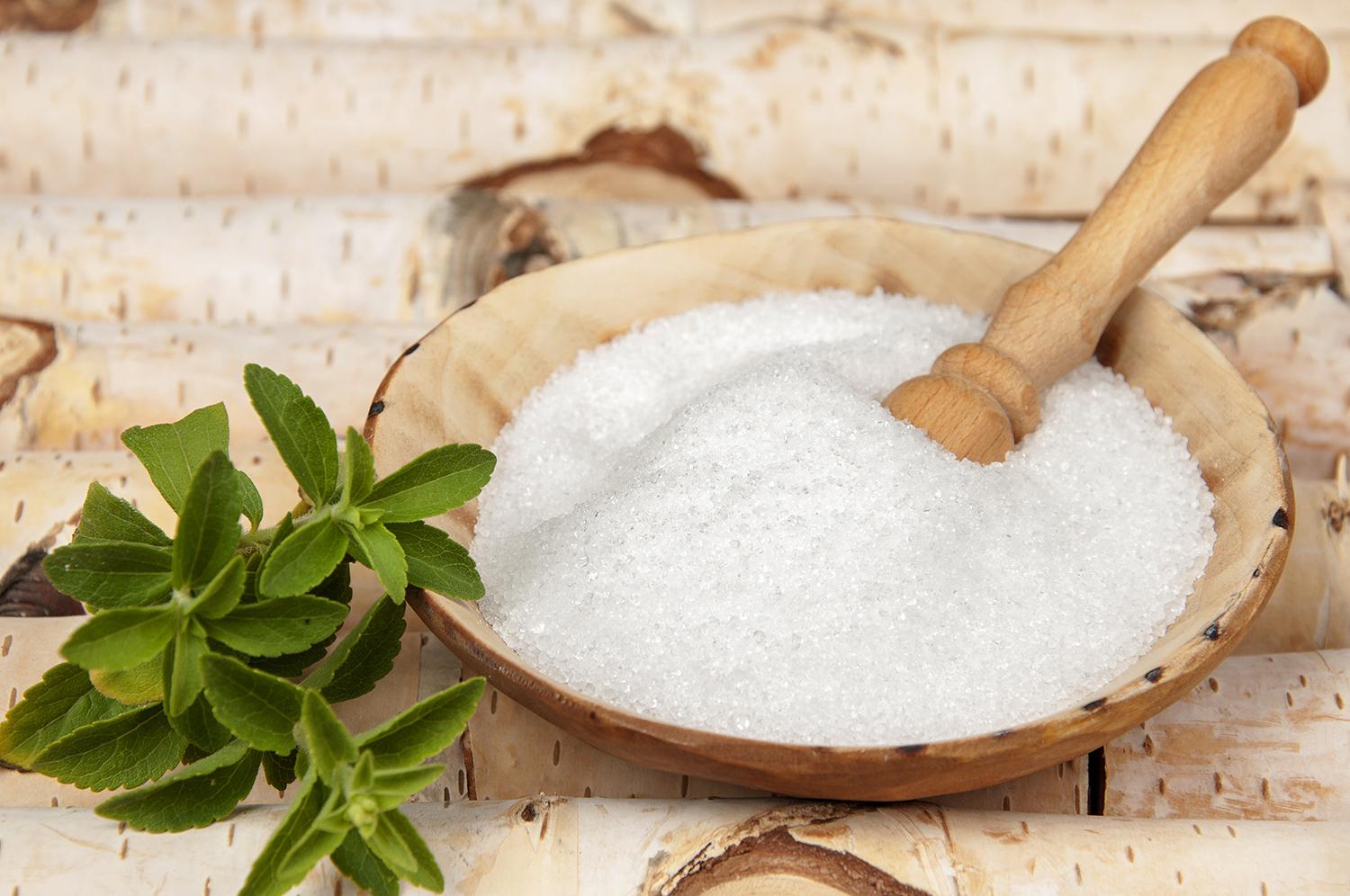

Satisfy cravings with natural sweeteners like stevia and monk fruit. (dedek/Shutterstock, Hajai Photo/Shutterstock)
It is worth noting, however, that animal studies suggest eating stevia long-term may potentially have adverse effects on the liver and kidneys or alter the gut microbiome. These findings are contentious, as other research indicates stevia may benefit patients with chronic kidney disease and ameliorate liver and kidney damage. Researchers have suggested the effects of stevia may depend on how much you eat and what it is eaten with.
The sweetness of pure stevia and monk fruit is several hundred times that of regular sugar. The powdered forms commonly found in supermarkets are typically blended with base ingredients. For example, you might find a composition of 1 percent steviol glycosides mixed with 99 percent erythritol. This means that the usage and quantities of these products are similar to regular sugar. Nevertheless, reading the usage instructions on the packaging is advisable so you understand serving sizes. The same applies to liquid stevia and monk fruit products, where the recommended amounts may vary. For some, one drop might be equivalent to the sweetness of a teaspoon of sugar, while others may require 10 drops or a few milliliters.
Artificial sweeteners, such as aspartame, sucralose, and saccharin, are commonly used as sugar substitutes in processed food and drinks labeled zero-sugar. However, numerous studies have found that these sweeteners can lead to metabolic syndromes, harm gut health, and may even be potentially carcinogenic.
Natural sugars are another excellent alternative. Honey, for example, while often equated with sugar, can actually help stabilize blood sugar when consumed in moderation. Moreover, honey has been used for thousands of years for its medicinal properties, particularly its antibacterial and antiviral effects. Certain types of honey, like Manuka, have a higher level of antibacterial properties compared to others. Collected from maple trees, maple syrup has a unique taste that captivates many and contains a rich array of nutrients. Coconut sugar is both anti-inflammatory and antioxidative, contributing to heart health.


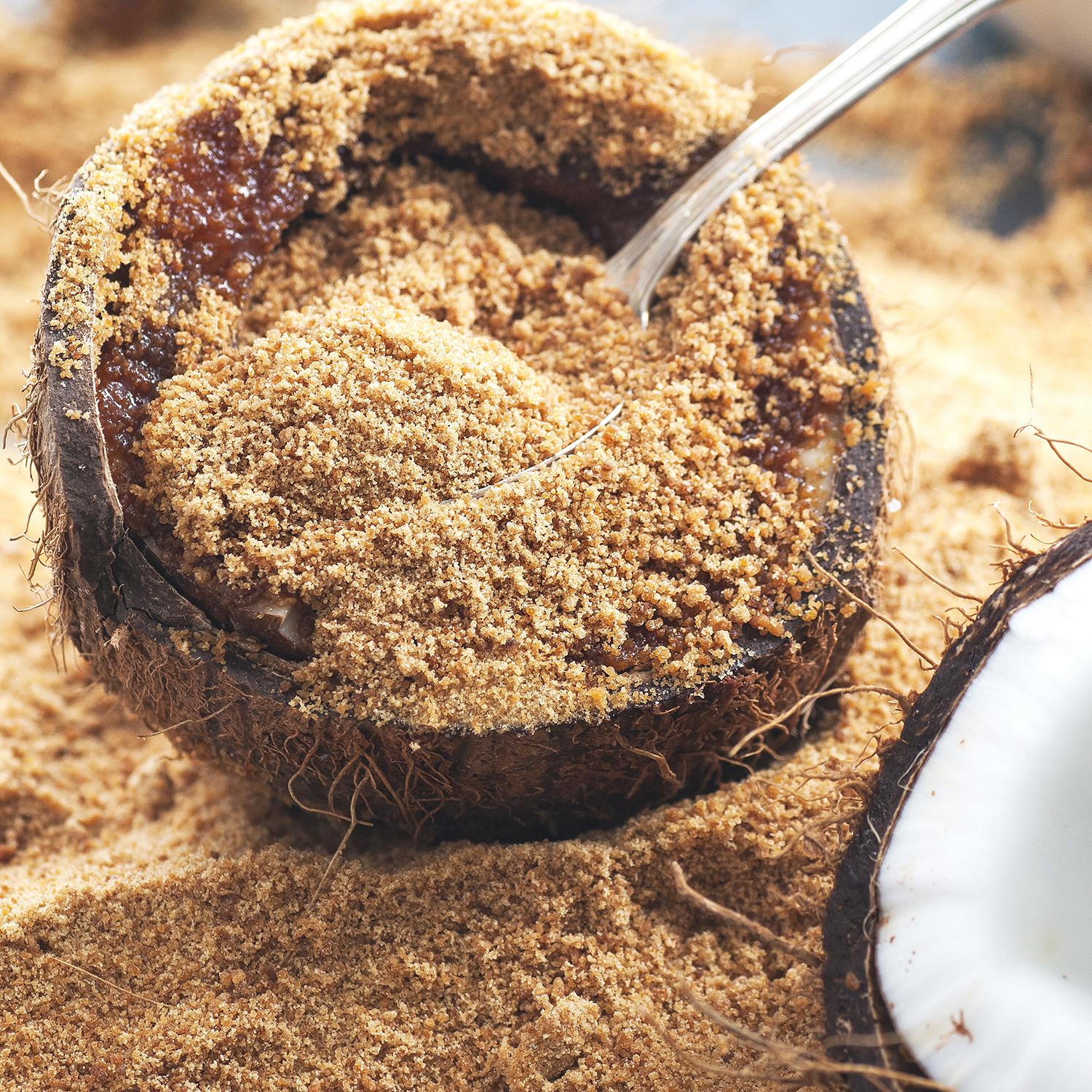
Natural sugars, such as honey, maple syrup, and coconut sugar, are other good alternatives. (Emi Yunita/Shutterstock, Marc Bruxelle/Shutterstock, Barbro Bergfeldt/Shutterstock)
A common practice is to use ½ to ⅔ cup of honey or ¾ cup of maple syrup to replace 1 cup (240 milliliters) of sugar.
Other ingredients also naturally carry a sweet taste. For example, Ms. Russo mentioned that licorice root has a natural sweetness and offers health benefits when used to make tea. Additionally, naturally sweet ingredients such as red dates and dried goji berries can be used to brew tea or soup that is both sweet and fragrant.
During interviews, many experts supported the idea of cooking at home as the safest and best way to avoid excess sugar. Choose natural, sugar-free ingredients like unsweetened yogurt and plain oats, and then sweeten with an appropriate amount of relatively natural sweeteners.
Replace Desserts With Fruits
Those with strong cravings for desserts and snacks can replace such treats with fresh fruits, said Dr. Luc Tappy, Professor Emeritus in the Department of Physiology at the University of Lausanne, Switzerland, in an email to The Epoch Times. The choice of fruits is generally not restricted.
Fruits come in abundant varieties, from common ones like blueberries and bananas to more exotic options like durian and mangosteen. Even the same type of fruit will come in different varieties in some tropical and temperate regions. The many kinds of desserts that can be made from these fruits are just as diverse. As you explore options, you will find that using these fruits can yield unexpectedly delightful flavors while satisfying your sweet tooth.
“The good things in fruit are far more important than the fruit sugar … in fruit,” Ellen Kampman, a nutritional epidemiologist and chair in nutrition and disease at Wageningen University in the Netherlands, told The Epoch Times. “So I’m not afraid that people might overeat [them].”
However, Dr. Tappy pointed out the importance of being mindful of portion sizes. Initially, when reducing sugar intake, consuming up to three servings of fresh fruits per day is recommended, which can later be reduced to two servings. A comprehensive study published in 2021 suggests that consuming two servings of fruits per day is ideal and healthy. One serving typically corresponds to one medium-sized piece of fruit or approximately 80 grams.
Dr. Fung warned that the fruits we consume today are generally much sweeter than 50 years ago, indicating increased sugar content. Individuals, especially those with blood sugar problems or a strong sugar addiction, should opt for low-GI fruits and avoid high-sugar fruits like grapes and bananas; the intense sweetness of such fruits may also trigger sugar cravings.
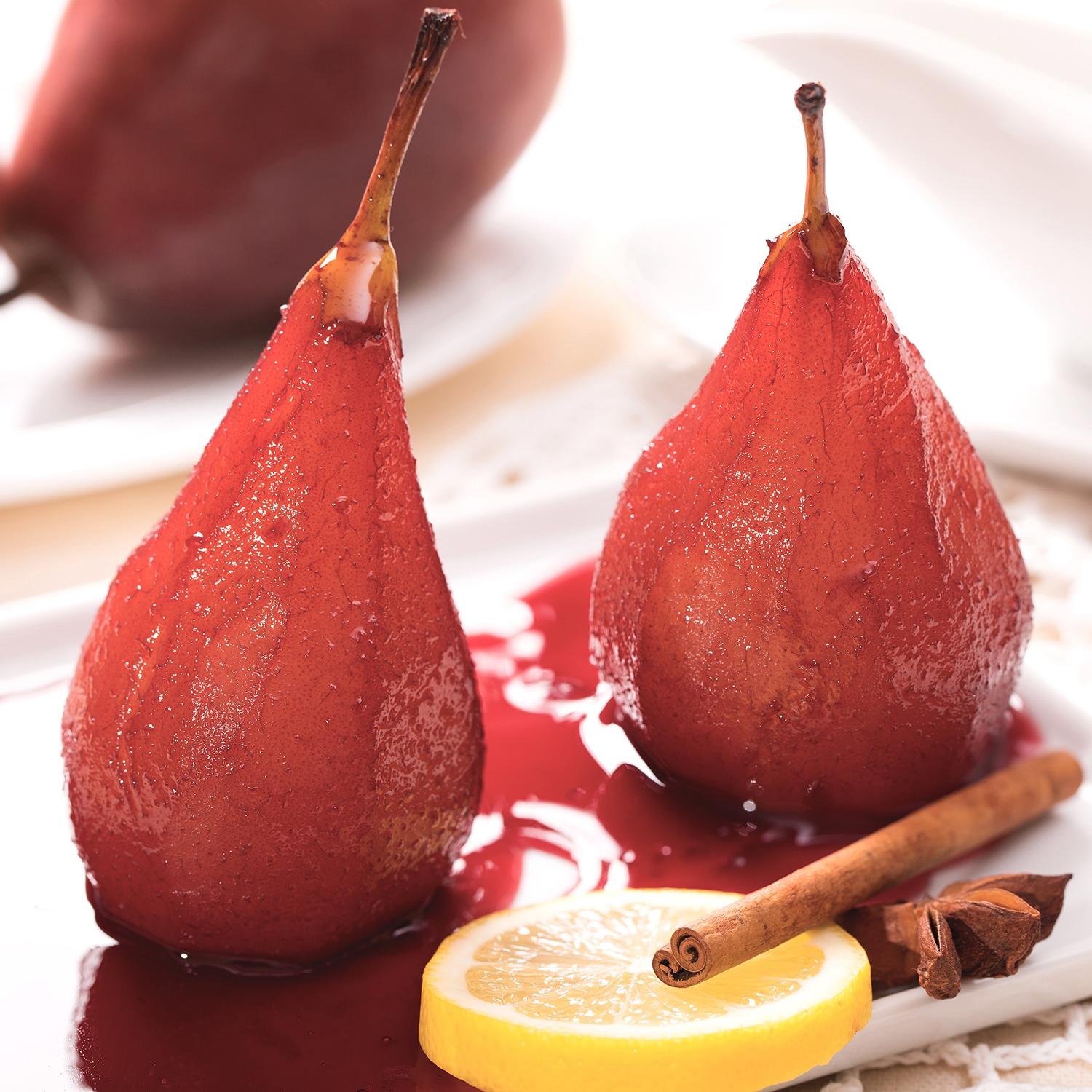


Using fresh fruits to make desserts can yield unexpectedly delightful flavors while satisfying your sweet tooth. (yingko/Shutterstock, Strokan/Shutterstock, Ika Rahma H/Shutterstock)
Cooking methods also impact fruit sugar content. Dried fruits shrink during the sun-drying or dehydration process. While eating one apple might fill you up, eating apple chips might lead you to easily eat two or three dehydrated apples without even realizing it. When consuming dried fruit, we must calculate based on the original size of the fruit. Fruit juice also concentrates sugars from multiple fruits while filtering out the dietary fiber. In an 8-ounce cup of orange juice, you are essentially getting the sugar and calories equivalent to three oranges.
In addition to fruits, Ms. Russo also mentioned that one can replace traditional desserts with a small piece of low-sugar dark chocolate after dinner. This not only provides satisfaction but also a sense of ritual. Furthermore, dark chocolate is rich in magnesium, and the lack of the mineral is often why many women crave chocolate before their menstrual periods.
Step 2: Crush the Desire for Sweetness
Truly and completely quitting sugar takes more than just following a method; you must first delve into the underlying cause of your cravings.
“Our choices we make influence how we feel, and how we feel influences the choices we make. This is a cycle,” said Steve Anton, professor in the Department of Physiology and Aging at the University of Florida, who holds a doctorate in clinical and health psychology. “If you can find healthy ways to help yourself feel good, you’re going to be less likely to [have] cravings.”
The Ultimate Guide to Kicking Sugar
How Sugar Changes Your BrainPart 2 Stevia: A Popular Sweetener That Lowers Blood Sugar, Fights DiabetesPart 3 A Natural Sweetener That Could Combat COVID, Diabetes, and CancerPart 4 Can Honey Fight Diabetes?Part 5 Honey Fights Bacteria and Viruses, Could Be Better Than AntibioticsPart 6 Is Maple Syrup a Healthy Sugar?Part 7 Coconut Sugar: Anti-Inflammatory, Heart-Protective, Nutrient-Filled BenefitsPart 8 10 Surprising Things Happen After You Stop Eating SugarPart 9 How Overeating Added Sugar May Lead to Mental DisordersPart 10 How Sugar Harms Your Gut and Increases Colorectal Cancer RiskPart 11 How Sugar May Be Linked to Autoimmune DiseasesPart 12 The Ultimate Way to Cut Out Sugar
More from this series
Craving Sweets Is a Sign of Unmet Nutritional Needs
People crave sugar partly due to an imbalance in food choices.
Mr. Anton explained to The Epoch Times that the combination of healthy fats, proteins, and complex carbohydrates (like vegetables, whole grains, and root vegetables) in our diet helps maintain healthy blood sugar levels after meals, contributing to overall well-being. These macronutrients slow digestion, reducing the speed at which glucose is released into the bloodstream. When there is an imbalance in the food consumed, the body struggles to maintain optimal energy levels, resulting in a rapid drop in blood sugar. In response, the brain quickly sends out signals for cravings, attempting to raise blood sugar by encouraging us to eat sweet foods.
Which type of nutrient is best at thwarting sugar cravings? “If I had to pick one, I would probably take the protein,” said Mr. Anton. Protein helps us maintain a feeling of fullness for an extended period. It increases satiety hormones, reduces hunger hormones, and promotes glucagon secretion, thus stabilizing insulin levels.
Many experts suggest opting for protein-rich foods if you really feel like snacking. These can sometimes be “the magic key” to reducing the desire for sweetness, said Ms. Gonzalez.
Overall, proteins play a vital role in our bodies and life processes. They break down into amino acids, which our body uses as neurotransmitters to produce enzymes and antibodies and aid in constructing the body’s tissues.

Many experts suggest opting for protein-rich foods if you really feel like snacking. (Illustration by The Epoch Times, Shutterstock)
It is also important to distribute protein evenly across three meals.
A small-scale study at the University of Texas revealed that eating the same amount of protein at every meal—in this case, 30 grams (roughly equivalent to the size of an adult’s palm)—is more beneficial than eating different amounts and skewing the intake more heavily at lunch and dinner. However, data from the National Health and Nutrition Examination Survey suggest that American adults tend to get most of their protein at dinnertime.
Studies have also found that a diet high in fat reduces sugar cravings. In a clinical trial published in Nutrients, overweight or obese participants, after following a high-fat, low-carbohydrate diet for four weeks—where carbohydrates constituted only 14 percent of total energy, with most of the energy coming from fat, then protein—experienced a decrease in cravings for sweets. Notably, women exhibited a more pronounced reduction in cravings than men.
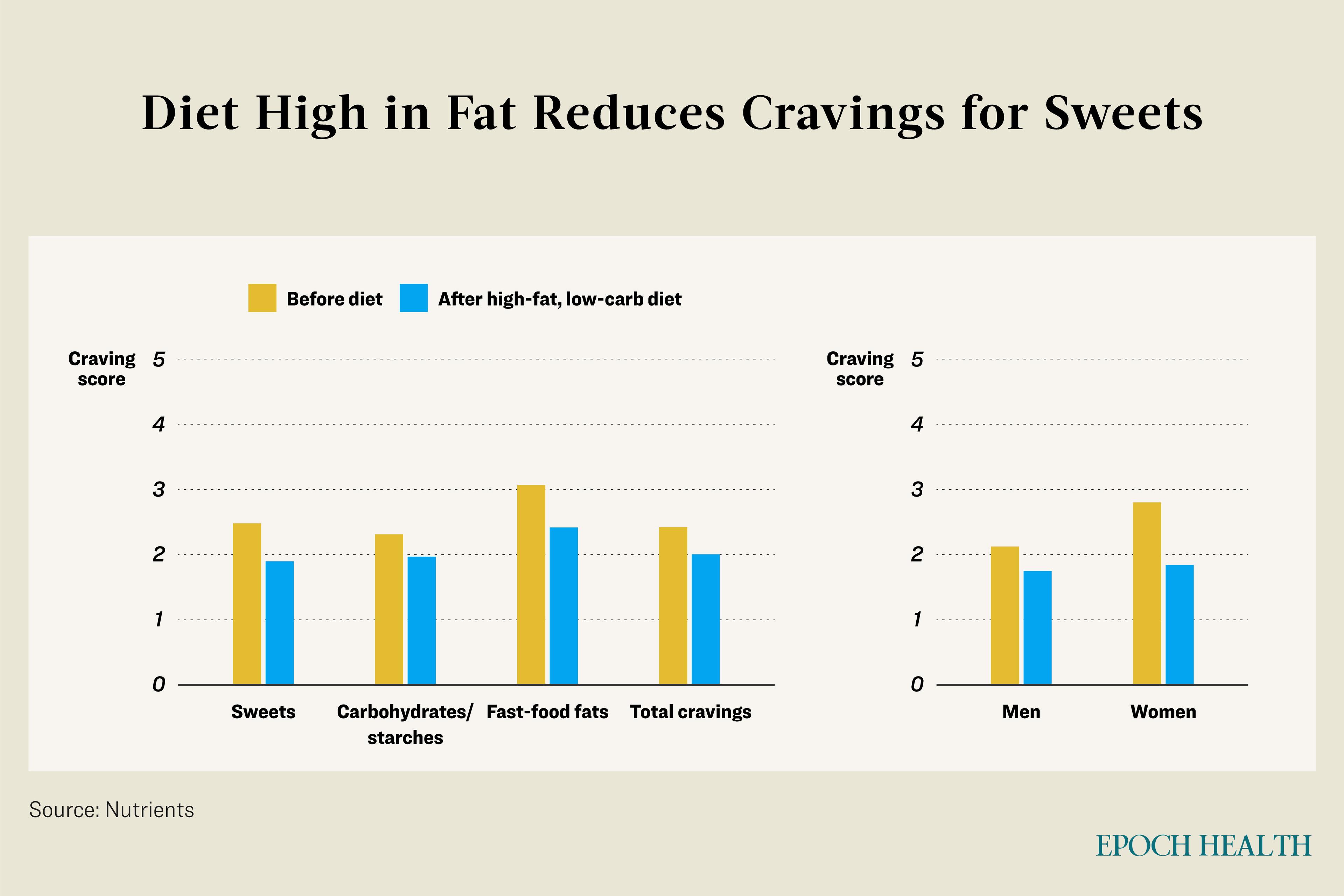
Overweight or obese participants, after following a high-fat, low-carbohydrate diet for four weeks, experienced a decrease in cravings for sweets. (Illustration by The Epoch Times)
Ms. Gonzalez believes many people consume the wrong types of fats—often an excess of vegetable oils. Contrastingly, healthy fats like olive, avocado, and coconut oils can help us feel satiated. She also highlighted the nutritional benefits of grass-fed butter, emphasizing its abundance of vitamin K and omega-3 fatty acids.
“Metabolism is our ability to convert food into energy. The better you maintain your metabolism—the more you feel energy in the body—the less you crave sugar,” said registered dietitian Cindy Chan Phillips. A high-sugar diet negatively impacts metabolism, resulting in insufficient energy for cells.
After eliminating foods with high added sugar, the body shifts from primarily relying on sugar for energy to obtaining energy from protein and healthy fats, leading to a more flexible metabolism, Dr. Gillaspy added.
Sugar Cravings Also Signal Mental Distress
Another reason we eat sugar is to fill emotional gaps or find a release. “I think you have to find other ways,” said Ms. Russo.
It is crucial not only to overcome physical addiction but also to address psychological habits or emotional cravings.
“What we are chasing is not so much a cookie; we are chasing the feeling,” said Ms. Phillips. She mentioned that many individuals, from a young age, never learn how to deal with negative emotions. When uncomfortable feelings arise, they often choose to avoid confronting them and, therefore, turn to sugar as a temporary relief.
In an observational, transversal study, over 77 percent of women experiencing higher levels of stress showed a craving for sweets. They also behaved differently compared to women who weren’t stressed. A seven-day experiment involving 142 university students showed individuals experienced a 5 percent to 26 percent increase in their craving for sweets on days marked by higher emotional tension.
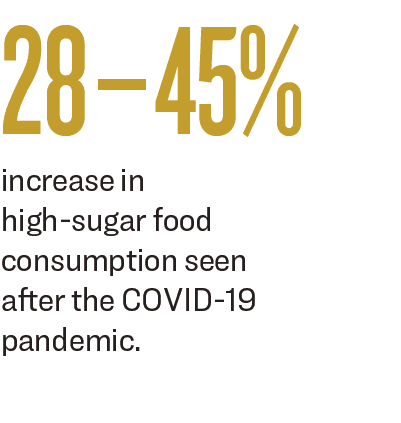
During the COVID-19 pandemic, the consumption of high-sugar foods increased by 28 percent to 45 percent. Individuals who reported an increase in food cravings under stress were over 11 times likelier to increase their consumption of high-sugar foods, while they were six times likelier to eat more processed food.
This is not entirely our fault; the moment sugar touches our taste buds, receptors on the tongue send signals to the brain that trigger the release of dopamine, which can induce feelings of satisfaction and happiness. This reward sensation makes it difficult for people to resist sweets.
Find New Ways to Trigger Dopamine Release
Fortunately, consuming sugar is not the only activity that generates dopamine.
Over the past few decades, an increasing number of neuroimaging studies have indicated that engaging in activities that bring pleasure stimulates the brain to produce dopamine. These diverse yet positive activities share remarkable overlap in the brain regions they impact. The events covered in these studies are vast, encompassing delightful foods, relationships with partners, friends, and family, and engagement with music, art, meditation, and other sources of happiness in life, such as helping others.
More Articles

How Sugar Fuels Cancer in the Body

10 Surprising Things Happen After You Stop Eating Sugar
In an earlier study, researchers conducted brain scans on participants and found a 65 percent increase in dopamine release in the brain during meditation compared to the control group.
When we view a photograph of someone with whom we are in love, the areas in our brain closely associated with dopamine activity immediately activate.
The dopamine concentration and turnover in the brain also increase when we view paintings and listen to music.
Additionally, exercise can generate dopamine, helping people overcome aversion to activities they’d rather avoid. For many, going for a run when under high stress helps them get through the day.
In one study, 78 regular chocolate eaters were divided into two groups: one engaged in a 15-minute brisk walk, and the other rested sitting down. Though participants were allowed to eat chocolate freely, there was a significant reduction in the brisk-walking group’s desire for and consumption of chocolate. The resting group experienced only half a reduction.
Kenneth Blum, a renowned scientist who has a doctorate in neuropharmacology and is a full professor at the Western University of Health Sciences Graduate School of Biomedical Science in California, shared the following “true dopamine” checklist:
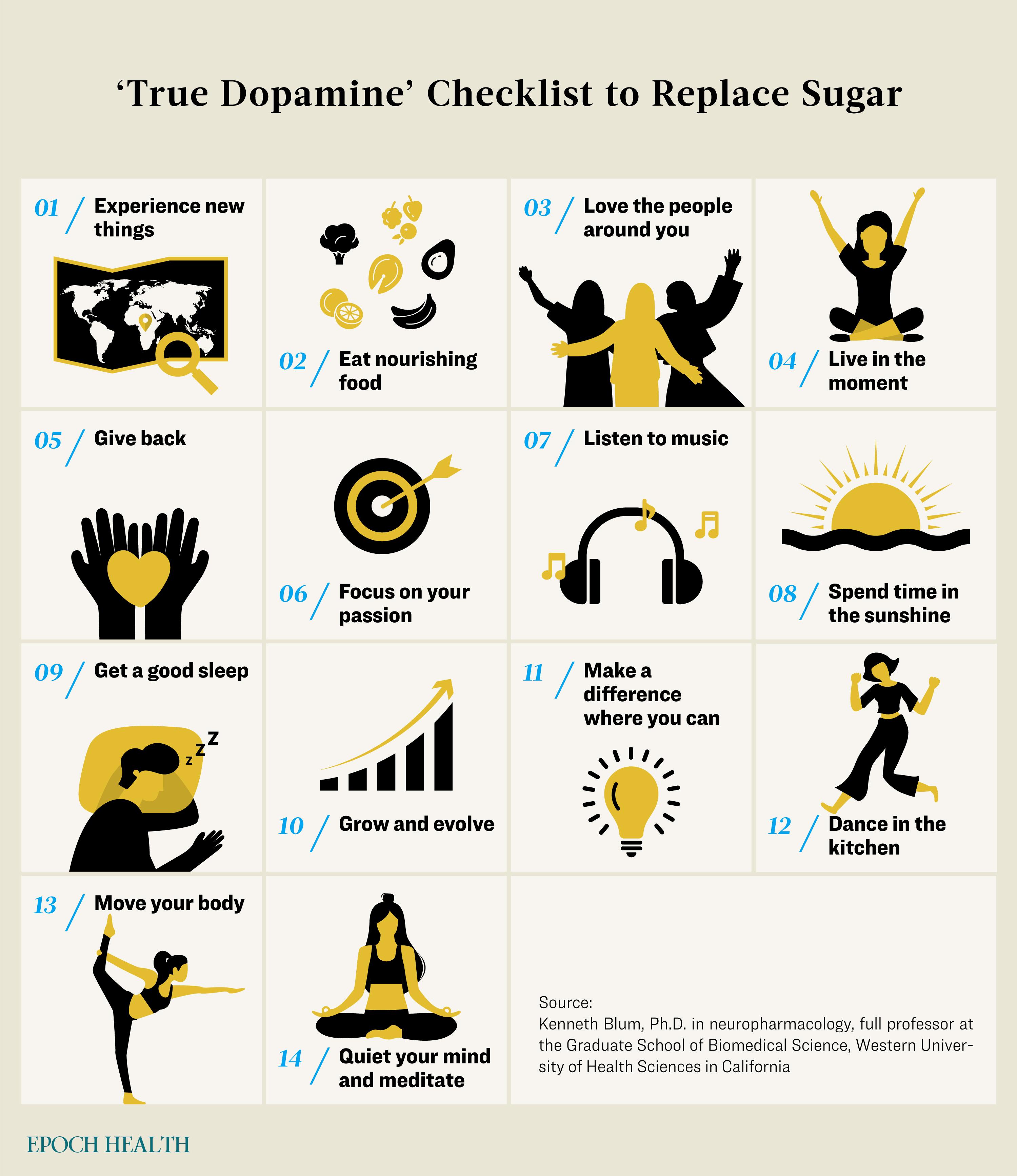
“True dopamine” checklist. (Illustration by The Epoch Times, Shutterstock)
You can prepare a range of simple and effective “true dopamine” strategies in advance “because the urge happens so fast,” said Ms. Phillips. Often, to cope with negative emotions, easily accessible sweets or snacks rich in refined carbohydrates become the fastest solution. Having a plan for such situations puts better coping mechanisms in place when the urge to eat sweets arises.
Ms. Phillips also encourages people to write down their troubles. Upon doing so, the temptation “reduces in intensity, [and] it does not live in your head as much anymore.”
Consider incorporating journaling as a stress-relief tool, too. You can place a diary and pen on the bedside table, dedicating a few minutes each night to pouring your thoughts into it, like talking to a best friend. Journaling offers an opportunity for self-reflection with no right or wrong, no specific structure, and no need for content filtering, said Ms. Russo.
Additionally, she suggests balancing the mind and body through meditation. “When your distracting thoughts come in, just gently push them to the side and let them go,” she elaborated. Ms. Russo said to start by trying to meditate for five minutes twice a day, gradually extending the meditation time to 20 minutes per session.
Utilize ‘Stop Objects’ to Quit Sugar
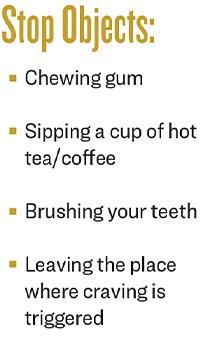
Humans have experienced food scarcity throughout history, leading to an adaptation that allows us to eat even when full. Dr. Gillaspy talked about using “stop objects” to resist the urge to continue eating or consuming sugar.
Stop objects can be chewing gum that alters the taste in your mouth; a cup of hot tea, where the gradual sipping process gives your stomach some time to signal to the brain that you are full; or brushing your teeth, as the freshness in your mouth helps prevent the desire to consume anything else.
Sometimes, simply leaving the space where the craving was triggered helps, suggested Ms. Phillips. Moving from the dining room to the bedroom may help you overcome the desire for emotional eating.
Out of Sight, Out of Mind
Strategically placing cookies at the back of the cupboard and ice cream beneath other foods can be beneficial. Even though you know exactly where they are, keeping them out of sight can help manage sugar cravings. Research indicates that visual food cues increase physiological responses and cravings, potentially leading to increased food consumption.
“If the sugary foods are not in your home, then you don’t have to muster up willpower to avoid them,” Dr. Gillaspy reasoned.
While natural sweeteners can serve as a crutch to reduce added-sugar intake, several experts stressed that their sweetness can still stimulate the part of the brain that craves sugar. Therefore, gradually distancing oneself from them may be worthwhile when aiming to quit sugar entirely. This involves slowly letting go of support and walking independently, obtaining your sweetness and satisfaction from natural foods alone. Quitting sugar will serve as a reset for both the brain and the taste buds.
